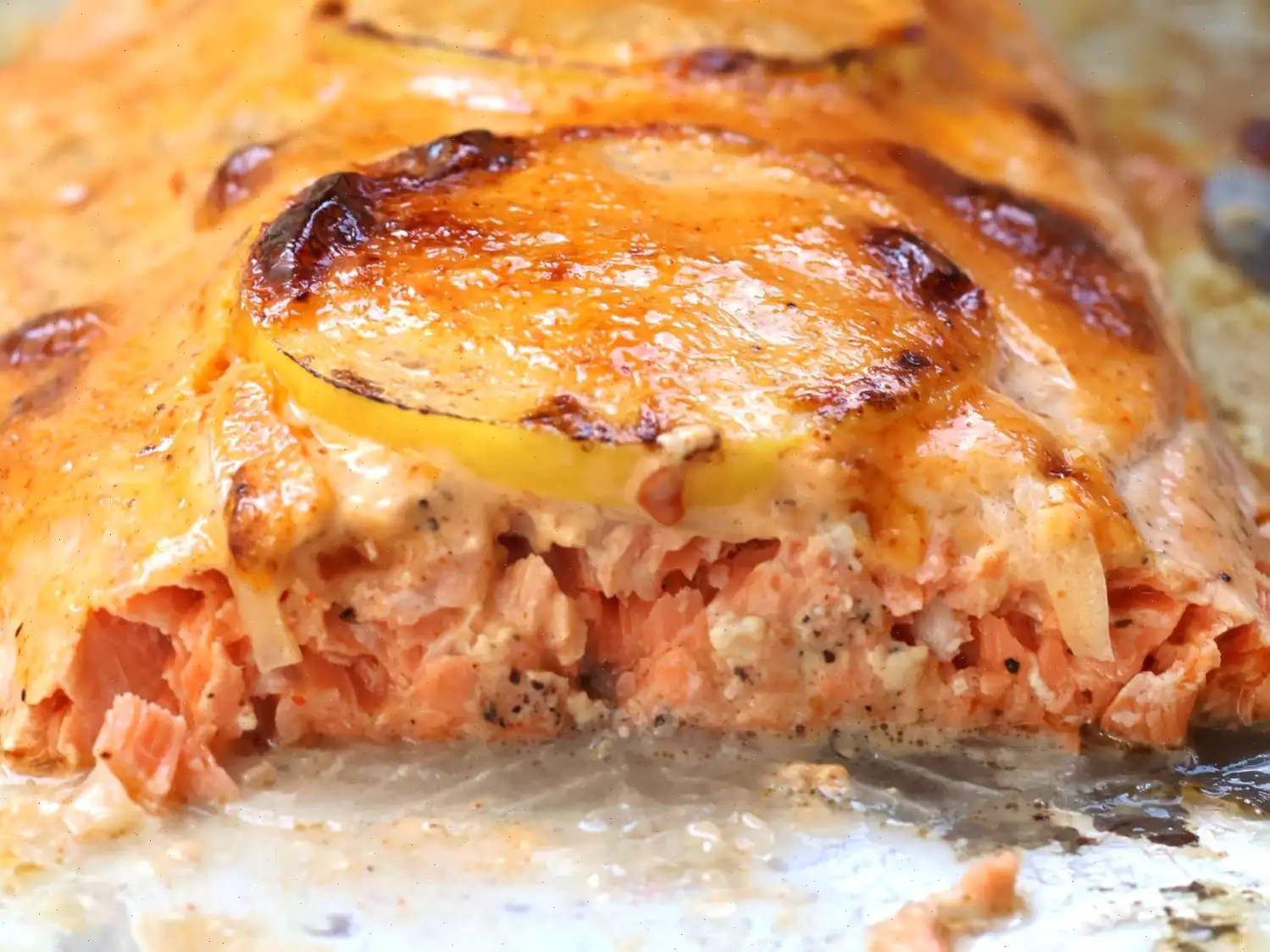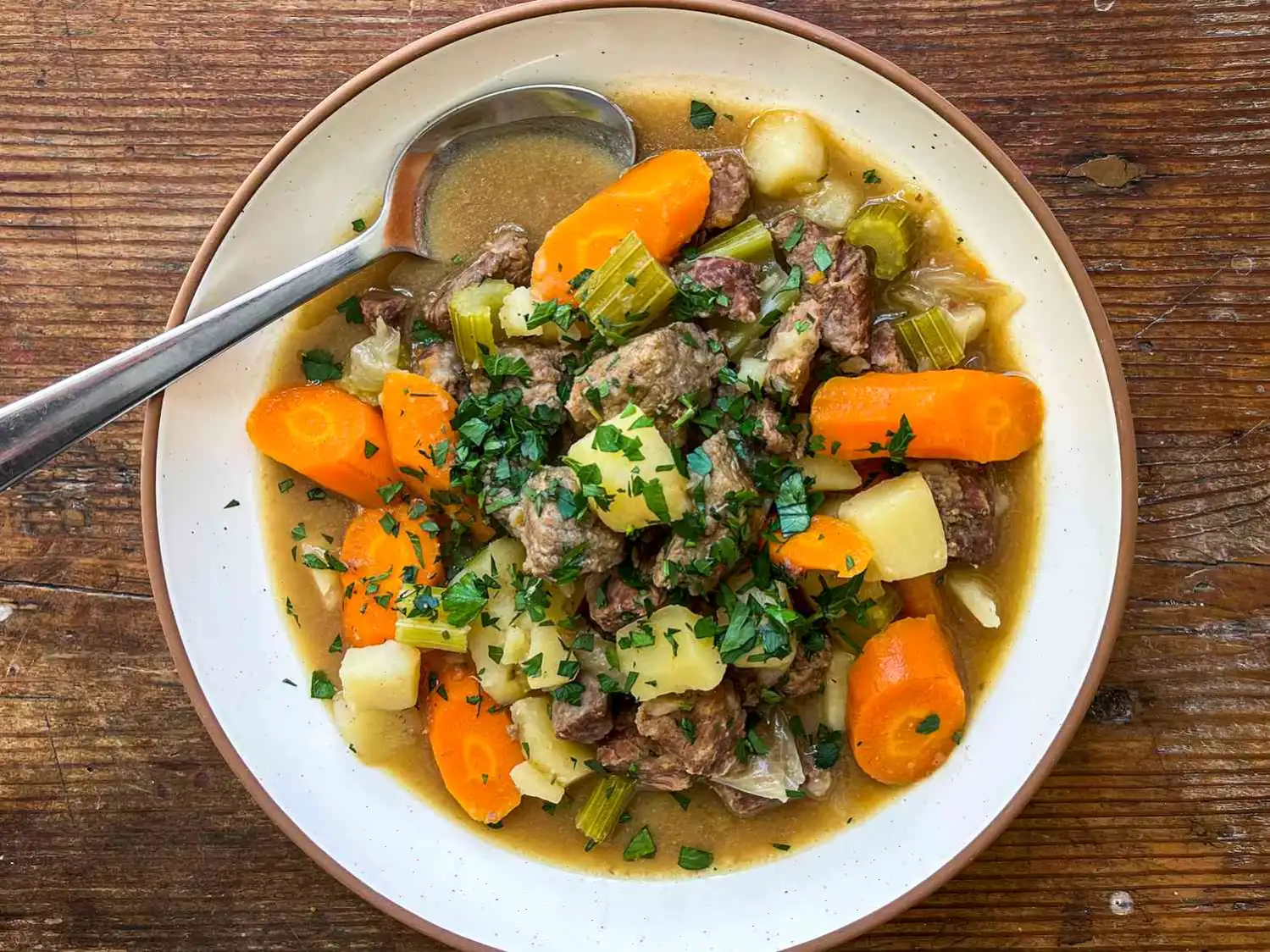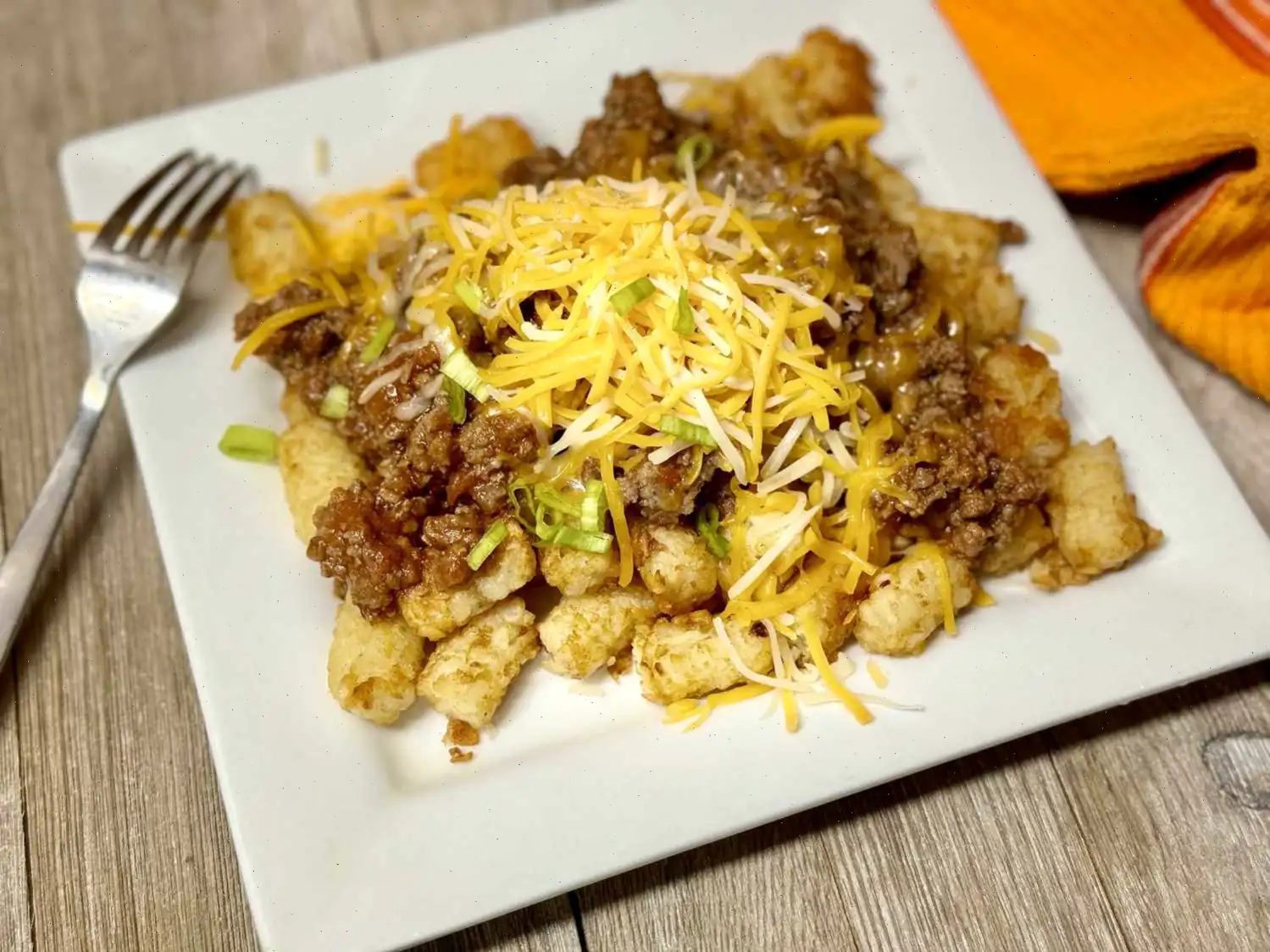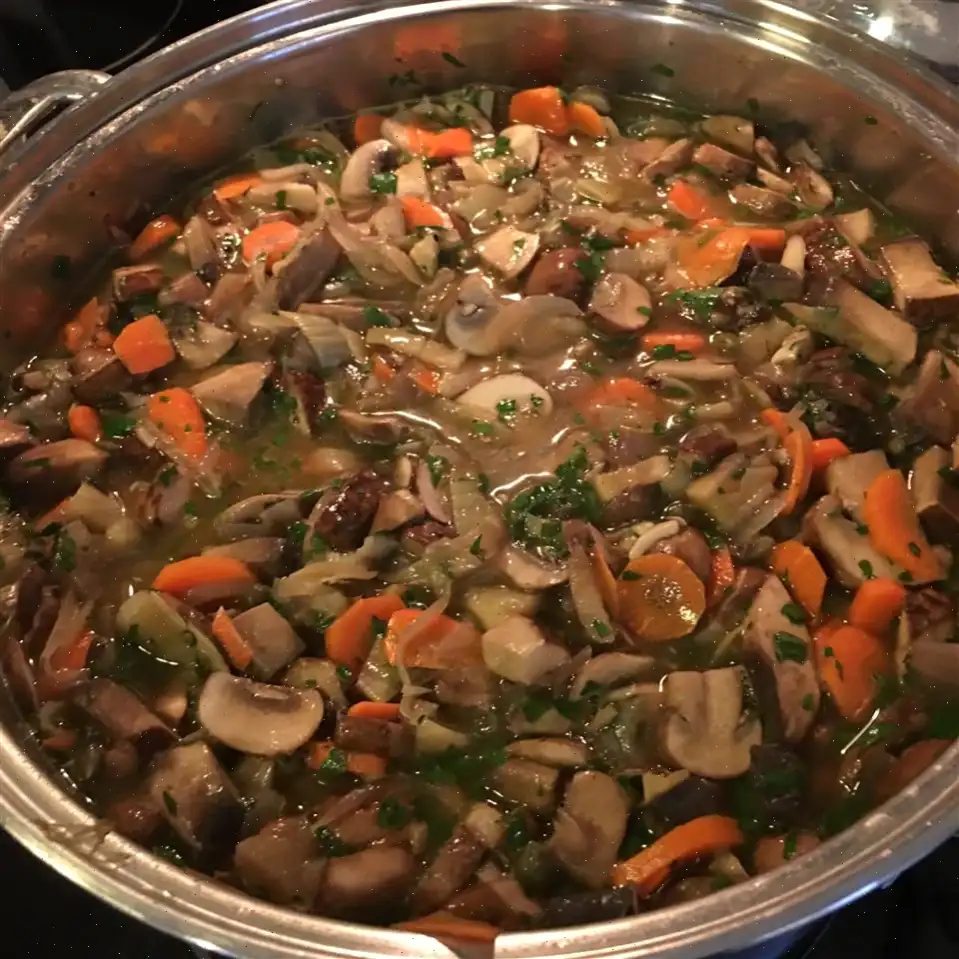
Harissa Baked Salmon
Baking a salmon may be the easiest way to ensure it comes out perfectly, and this recipe is no different. All your ingredients go into a baking dish together the salmon, lemon slices, onion rings, wine, orange juice, and sauce and everything will roast for 10 to 12 minutes at 425F (220C), followed by a quick 3-minute broil. The time required to bake salmon can vary depending on the size of your fillet, but 10 minutes should be a good starting point. As a general guideline: every inch of thickness requires about 10 minutes to cook. If your fillet is a little thinner, aim for 8 minutes. If it's thicker, extend the time to 12 minutes. For accuracy, a cooking thermometer is key when the internal temperature reaches 145F, the salmon is ready.
The harissa sauce is what brings this recipe to life. Harissa, a spicy, tangy red chili paste from Tunisia, is widely used in North African and Middle Eastern cooking. In this recipe, it's combined with mayonnaise, lemon juice, and smoked paprika to create a sauce thats flavorful and mildly spicy. If you like your dishes hotter, feel free to add a bit more harissa or smoked paprika.
Ingredients (Serves 4)
- 1 teaspoon vegetable oil
- 1 pound wild salmon fillet
- Salt and pepper, to taste
- 4 thin slices lemon
- 2 thin slices sweet onion, separated into rings
- cup mayonnaise
- 1 teaspoon lemon juice
- 1 teaspoon harissa
- teaspoon smoked paprika
- 1 tablespoon orange juice
- 1 tablespoon white wine
Directions
- Preheat the oven to 425F (220C). Coat the inside of a 9x12-inch baking dish with vegetable oil.
- Place the salmon fillet into the prepared baking dish, then season with salt and pepper.
- Arrange the lemon slices and onion rings on top of the salmon.
- In a separate bowl, mix together the mayonnaise, lemon juice, harissa, and smoked paprika until well combined. Spread this mixture over the salmon, lemon, and onion slices.
- Drizzle orange juice and white wine around the salmon.
- Bake in the preheated oven for 10 to 12 minutes, or until the salmon is hot and begins to turn opaque.
- Remove the baking dish from the oven. Set the broiler rack about 5 inches from the broiler, and turn the broiler on.
- Broil the salmon for 3 minutes, or until it is nicely browned and crispy on top.
Cooks Note
You can place the onion and lemon slices on top of the salmon after spreading the sauce, but they may burn easily under the broiler. Its best to add them at the start for even cooking.
Nutrition Facts (per serving)
- Calories: 380
- Total Fat: 29g (37% Daily Value)
- Saturated Fat: 5g (25% Daily Value)
- Cholesterol: 79mg (26% Daily Value)
- Sodium: 278mg (12% Daily Value)
- Total Carbohydrates: 2g (1% Daily Value)
- Dietary Fiber: 0g (2% Daily Value)
- Total Sugars: 1g
- Protein: 25g (51% Daily Value)
- Vitamin C: 10mg (11% Daily Value)
- Calcium: 24mg (2% Daily Value)
- Iron: 1mg (3% Daily Value)
- Potassium: 482mg (10% Daily Value)
* Percent Daily Values are based on a 2,000 calorie diet. Your daily values may be higher or lower depending on your calorie needs.
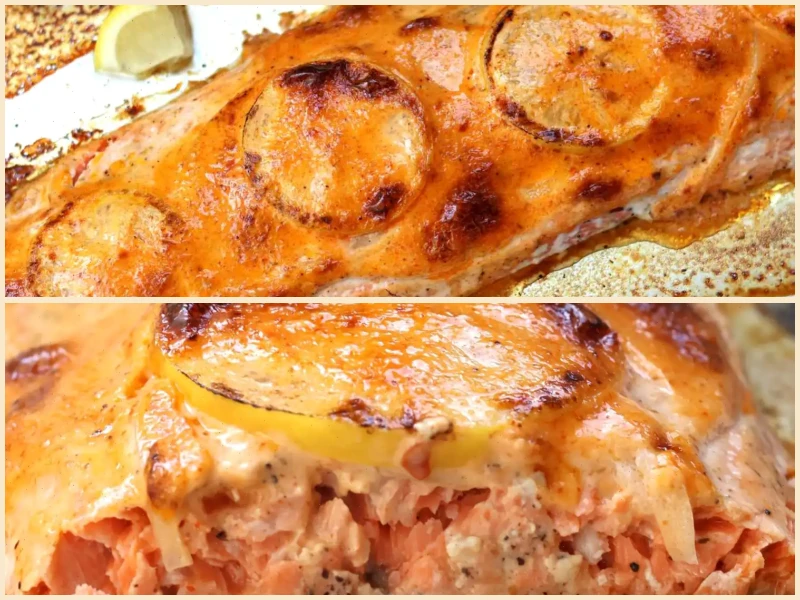
The Story Behind Harissa Baked Salmon
Harissa Baked Salmon is a modern culinary creation that blends traditional North African flavors with Western cooking techniques. Harissa, a fiery chili paste from Tunisia, has been a staple in Maghreb cuisine for centuries. Its combination of chili peppers, garlic, and spices brings depth and heat to dishes. The use of salmon, a fish native to colder northern waters, reflects the fusion of North African spice with the heartiness of American seafood cooking. This dish likely emerged as chefs and home cooks sought ways to introduce bold flavors to classic baked salmon, making it both exotic and accessible.
Regional Variations and Influences
Although harissa originates in Tunisia, variations exist across North Africa, including Algeria and Morocco. Each region adjusts the spice mix based on local tastes, sometimes adding coriander, caraway, or rose petals. In Western adaptations like Harissa Baked Salmon, the paste is often softened with mayonnaise or citrus juice, balancing the heat while preserving the aromatic complexity. Some American versions also incorporate smoked paprika or orange juice, which adds subtle smokiness and sweetness, highlighting regional preferences for nuanced flavor layering.
What Sets It Apart from Similar Dishes
Unlike traditional baked salmon recipes that rely on simple herbs and lemon, this dish integrates harissa to create a spicy, tangy, and slightly smoky topping. The combination of harissa with mayonnaise and smoked paprika differentiates it from dishes like honey-glazed or Dijon mustard salmon. Its bold flavor profile elevates the humble salmon fillet, offering a fusion of Mediterranean and North African influences that is both visually striking and flavorful.
Where You Typically Find It
Harissa Baked Salmon is often served in modern American bistros, Mediterranean-inspired restaurants, and home kitchens focused on global flavors. It is particularly popular as a dinner entre paired with roasted vegetables, couscous, or rice. Some upscale seafood restaurants feature it as part of a tasting menu, highlighting its exotic spice while maintaining the delicate texture of salmon.
Interesting Facts
- Harissa was originally made using sun-dried chili peppers, olive oil, and a mortar and pestle, a tradition that continues in many North African homes.
- The combination of citrus juice with harissa is a modern adaptation to balance the paste's spiciness and enhance the salmons natural flavors.
- Salmon is rich in omega-3 fatty acids, making this dish not only flavorful but also highly nutritious.
- Broiling the salmon for a few minutes at the end caramelizes the harissa-mayonnaise topping, creating a slightly crispy, smoky finish unique to this recipe.
- Harissa can vary in heat intensity; chefs often adjust the amount to suit diners tolerance, making the dish customizable for different palates.
You can listen to this recipe in AI audio format. Simply click the play button below to listen to the content in a format that suits you best. It’s a great way to absorb information on the go!
FAQ about Harissa Baked Salmon
Comments
Alexander Jones
08/11/2024 12:53:58 PM
Overall, not too shabby. Next time, I'll consider a different sauce instead of mayo and increase the amount of harissa and smoked paprika. I'm willing to give it another shot.


